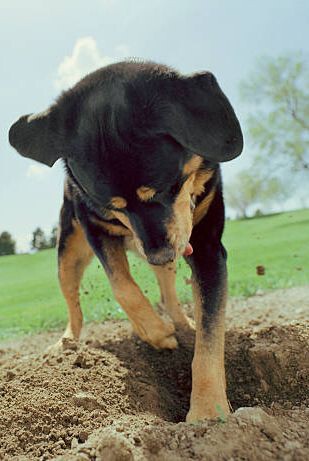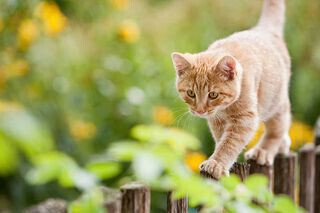You’d do anything to keep your pet safe and healthy—and with warm weather on on its way, you're probably itching to get outdoors more. But with so many temptations for pets in your garden, it’s smart to know what risks exist. “Cats and dogs are naturally curious,” says Debbie Chew, DVM, veterinarian at East Greenbush Animal Hospital in East Greenbush, New York. “Even animals that haven’t previously eaten anything may do so because they’re exploring. Young dogs are especially inquisitive.”
Here’s how to make your garden a safer place for your four-legged family members:
If you suspect your pet has eaten something, take action ASAP.
No matter how careful a pet parent you are, your cat or dog can get into something in an instant, says Chew. If you suspect your pet has eaten part of a plant—even if you aren't sure if that plant is poisonous to them—don’t hesitate to call your vet or the ASPCA’s pet poison hotline immediately (program the numbers into your phone right now!). And keep some pet first aid items on hand, such as 3 percent hydrogen peroxide. It’s used to induce vomiting—but use it only with your vet’s recommendation because some substances are not safe to vomit up.

Read up on dangerous plants.
If your pet is a nibbler, it’s best not to include certain plants in your garden. All types of lilies, including those in florist bouquets, can be deadly, especially to cats who can experience kidney failure from eating them, says Chew. Other toxic plants include daffodils, tulips, hyacinths, spring crocuses and irises. All parts of these plants can cause vomiting, diarrhea and drooling, but the bulbs are the most noxious part (so beware if your pet likes to dig!). Crocuses that bloom in the fall are even more hazardous, causing excessive vomiting or organ and bone marrow damage. Dangerous shrubs include azaleas, rhododendrons, and yews.
A more complete list of poisonous plants can be found here.
Fence off your veggie garden.
Surprisingly, some types of edible plants, such as those in the allium family (garlic, leek, chives, onions) can be toxic to pets if ingested in large quantities. “There are some plants you wouldn’t even think are unsafe for pets,” says Chew. That includes tomato plants and unripe tomatoes, which may cause vomiting and heart issues due to a substance called tomatine. Ripe tomatoes are not dangerous, however, because the tomatine decreases as the fruits ripen. Raised beds, tall enough for your pet not to reach, or hanging baskets are another option for keeping plants away from your pet.
Clean up after yourself.
Don’t let grass clippings, shrub trimmings, and other yard waste sit around in your garden. “I had one dog eat an entire pile of grass clippings and pine needles and require surgery,” says Chew. “You never know when or why they will eat something, so you should never leave your pet unsupervised in the yard.”
Avoid using cocoa bean mulch.
It’s pretty and has an appealing scent, but, like chocolate, this type of mulch is irresistible and dangerous for dogs. Ingesting it can cause rapid heart rates, seizures, and death.
Keep your pet away from fertilizers, herbicides, and pesticides.
Follow the package instructions, and keep your pet indoors during application. Make sure products are watered in when appropriate, and read the label to know when it’s safe to re-enter a treated area. Did you know organic fertilizers are just as dangerous? Bone, blood, and fish meal are delightfully stinky and enticing to dogs. Eating these substances can cause joint and muscle pain or stiffness and products can clump in the stomach or GI tract, causing a blockage, according to the American Animal Hospital Association. Even compost can be risky because decaying plant matter may contain toxins that cause seizures, while toxic food leftovers, such as grapes or onions, may be present in partially decayed compost, says Chew.
Skip the rodent poison.
Got moles or voles? If you’re trying to rid your garden of rodents, avoid using poisonous baits in granule, pellet, peanut-shaped, or brick form. It’s far too easy for your pet to get into these products before you even know it. Ditto for ant or slug baits. While you’re at it, don’t let your pet wander into the neighbor’s yard where you have no idea what’s being used. A few simple precautions are all it takes to keep your fur baby safe in the Great Outdoors.